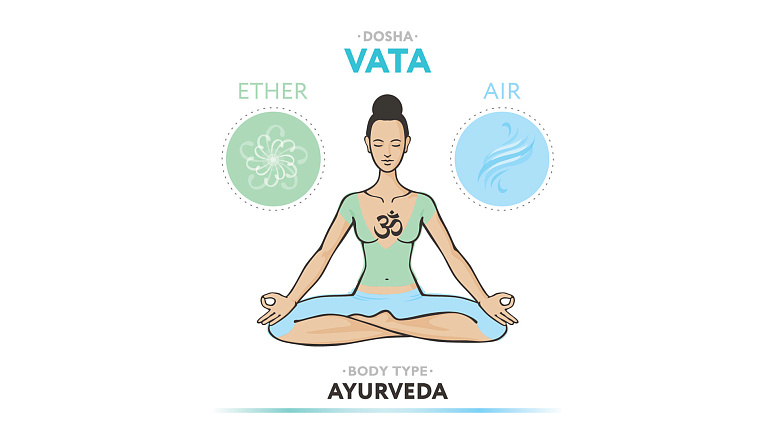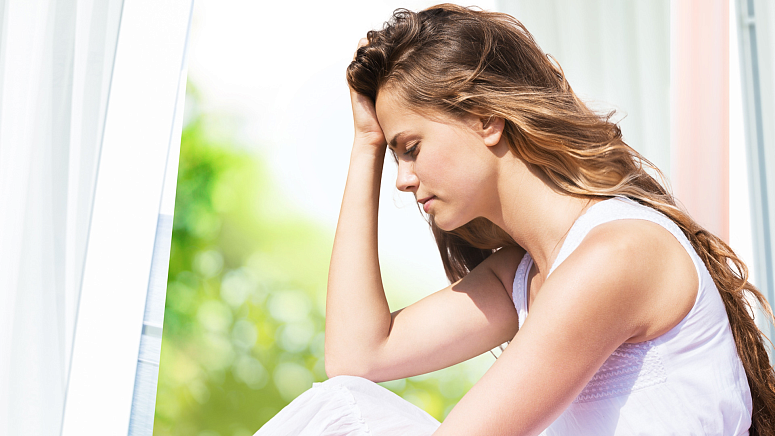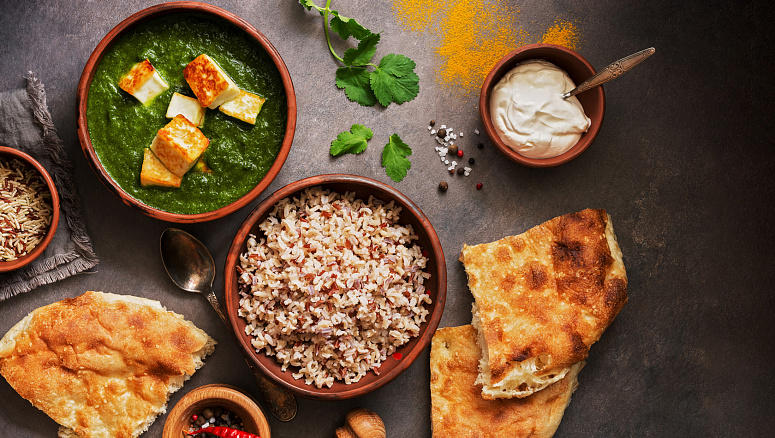Vata dosha consists of the elements of ether and air. Thanks to the wind energy inherent in Vata dosha, people who are dominated by it are characterised by enthusiasm, easy decision making and creativity. These people are savvy and open to new experiences. In this article, we will go over all character traits, body type and diet for people with Vata constitution.
Ayurveda believes that the entire universe is composed of five elements: ether, air, fire, water and earth. These elements are manifested through a combination of doshas. Dosha is the central concept in Ayurveda. Doshas are three energies that determine each person's unique mind-body constitution, appearance, behaviour, as well as emotional and physiological characteristics of a personality.
Vata dosha manifestations
In order to characterise Vata dosha, we need to examine its qualities. Vata has a light, dry, mobile, cold, hard, rough, sharp, subtle, fluid and transparent nature. Vata-dominated body and mind reflect these qualities.
Vata dosha consists of the elements of ether and air. It manifests in the physical body in the form of movement, nerve impulses, breathing, and blood circulation. According to Ayurveda, Vata is responsible for our mental and physical adaptability. This force excites the body and mind, controls the nervous system, the state of the musculoskeletal system, and the senses of touch and hearing.
Character of Vata people
Wind energy endows people with enthusiasm, easy decision making and creativity. These people are savvy and open to new experiences. They are also active and like to be on the move and travel. They absorb information rapidly and forget it just as quickly. Cosy home atmosphere and soft fabrics in clothes provide them inner balance.
Spontaneity of Vata people sometimes leads to rash spending. On the other hand, if in balance, people of the Vata type remain bright, friendly and creative throughout their lives. An interest in the spiritual side of life can, with a regular practice, lead to the positive results in meditation.
Physical characteristics of Vata dosha
Vata people are usually shorter or taller than average, thin, and do not possess great strength and endurance. Their skin is cold, rough and sometimes has cracks. Fine wavy hair is often dry and brittle. Sleep is restless and shallow. Cold hands and feet are the result of poor blood circulation. Vegetative-vascular dystonia (VVD), digestive disorders, intestinal problems and diseases of the musculoskeletal system are common problems among Vata people.
Causes of Vata dosha imbalance
If Vata is out of balance, a person may experience fear, anxiety, loneliness, psychological instability and impatience. Another sign of imbalance is excessive emotionality and attachment that flares up quickly and fades away just as quickly.
Vata dosha imbalance can be caused by travelling, frequent changes in life and nocturnal lifestyle. Raw vegetables, cold food and drinks, exposure to cold or wind contribute to the increase of Vata.
How to understand that Vata dosha is out of balance?
- Skin becomes dry, rough and thin.
- Weight loss.
- Constant whirlwind of thoughts.
- Worrying and fretting over nothing.
- Intestinal problems (constipation, gas).
- Insomnia.
- Forgetfulness.
- Crepitus or clicking joints.
- Getting tired easily.
Basic principles to restore Vata dosha balance
Ayurveda offers different approaches to restore Vata dosha balance: diet, herbs, aromatherapy, mantras, oil massage and daily routine. In any case, it is necessary to enhance the qualities that counteract the imbalance.
- If there is an excess of lightness (e.g., dry skin and hair, crepitus or cracking joints, hoarseness of voice, nervousness, etc), they should be balanced with heavy qualities that can be acquired as a result of good sleep, stable and measured life.
- In case of excessive cold (e.g., poor blood circulation, low pressure) increase heat by boosting your vital activity, harmonizing relations with others and consuming warm balanced food.
- In case of excessive rigidity (e.g., stomach problems, over-aggressiveness), decrease heat with a soft cooling diet, meditation and a calm yoga practice.
- Each tool of influence is extremely important. But the most important is a daily routine. Vata dosha can only remain in balance through the right lifestyle.
- It is advisable to to get up within half an hour of sunrise. Morning routines should include Abhyanga (oil massage), meditation and hatha yoga practice in addition to daily hygiene routines.
- You should eat regularly throughout the day. Thus, you can organise three to five meals and eat at the same time every day. It increases the heavy qualities and increases stability. Food should be oily, cooked and warm.
- You should go to bed at nine or ten o'clock in the evening. Although it depends on the latitude of your country of residence, the time of sunset and the season.
Vata dosha diet
- Sweet, sour and salty products.
- Warm, freshly prepared food.
- Warming spices.
- Warm or room temperature drinks.
- Dairy products during warm seasons.
- Warm milk flavoured with cinnamon and nutmeg an hour before or after another meal.
- Vegetable oils or ghee butter.
- Eating should take place in a quiet environment without TV, reading or looking at gadgets.
List of foods that are best to avoid
- Bitter and astringent foods.
- Cold products.
- Milk during mealtime.
- Dry and light foods (popcorn, crackers, crisps, croutons).
- Lots of raw food, especially in the mornings and evenings (e.g., salads, fruit, fresh fruit and vegetable juices).
- Most legumes, including soya beans.
- Hot spices such as cayenne pepper.
- Processed food (tinned, frozen).
- Cold or carbonated beverages.
- Caffeine, nicotine and other stimulants.
- Fresh fruit or fruit juices immediately after a meal.
- Foods or beverages containing refined sugar.
- Food fried in large amount of oil.
- Alcohol.
Recommended products
- Fruit: bananas, coconuts, apples, figs, grapefruits, grapes, mangoes, melons, oranges, papaya, peaches, pineapples, plums, cherries, apricots and avocados.
- Dried fruits are also healthy, but in small quantities and necessarily soaked, so as not to increase dryness. It is better to eat fruit an hour before or after a meal, but not in the evening.
- Vegetables: asparagus, beetroot and carrots. Other vegetables can be eaten in small quantities if cooked in ghee or olive oil: peas, broccoli, cauliflower, zucchini and potatoes. Sprouts and cabbage cause gassiness and should be minimised.
- Grains: oats, brown rice, wheat. In smaller quantities: barley, corn, millet, buckwheat and rye.
- Legumes: mash, lentils.
- Sweeteners: cane or brown sugar.
- Dairy products and substitutes: ghee butter, fresh milk, paneer, soya milk, tofu.
- Spices: cardamom, cumin, ginger, cinnamon, cloves, mustard, basil, asafetida, coriander, fennel, oregano, sage, tarragon, thyme and black pepper.
- Vegetable oils all of them are healthy, especially sesame and olive oil.
In conclusion, it must be said that Vata dosha manages all the movements of the mind and body: it controls blood flow; moreover, it is responsible for eliminating toxins from the body, breathing and the thought process.
Since Pitta and Kapha need movement, Vata dosha is considered the primary among the three doshas. Therefore, balancing Vata dosha is essential for the healthy functioning of the body and mind.



